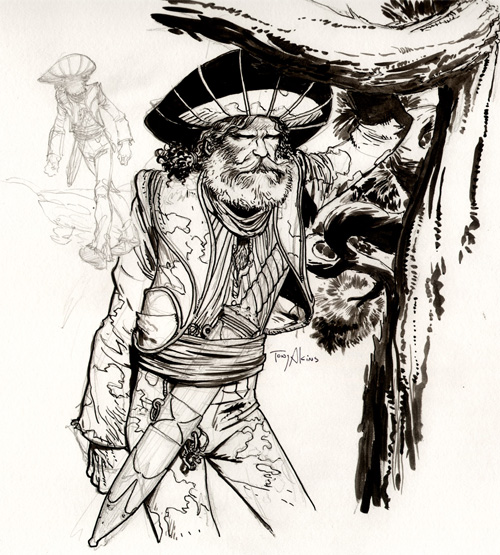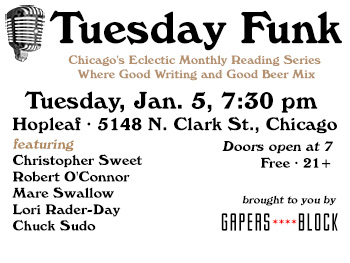| « The Great Chicago Book Sale | YOUmedia Digital Library Space for Teens » |
One-Shots Mon Oct 10 2011
One-Shots: Tony Akins
Delving into Tony Akins' career in comics yields a rich, multi-layered history. To say the Afro-Carribean-Irish Chicago native continues to follow in an artistic tradition is true and yet in some ways a misnomer -- although he comes from a creative background, Akins' choices and work display his definitive and detailed style. This is reflected in his work on Fables, Jack of Fables, Hellblazer: Papa Midnite, Elementals, and more.
Sadly, the possibility that Tony will leave here for Seattle in the not-so-distant future is high. I was lucky enough to talk with DC/Vertigo artist about his history and process before he heads west.
Name: Tony Akins
Job: Comic book artist
Age: Really!?
Education: Incandescent Drop-out, The School of the Art Institute of Chicago
Location: Ravenswood Manor
Hometown: Chicago, IL
Website: http://tonyakins.blogspot.com/
Favorite place in Chicago: Any place that presents an interesting aspect or view that seems to be just for me in that moment.
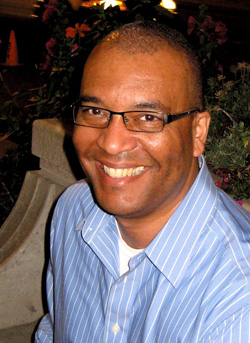

Self-portrait
You're originally from Chicago?
Yes I am. I was born on the South Side, raised on the South Side. I think St. Luke's Presbyterian Hospital, and raised at 66th and Marquette for the first few years of my life. Then we bought a house out near Avalon Park, which is out by Chatham, South Shore. My mother still lives in the same house.
South Side, but I guess a naturalized Northsider.
Your dad was an artist too, right?
He was a jack of all trades, which I guess he needed to be for the day. In my life he did everything from design signs, hand-paint signs, process, cut-out, hang in stores. He made signs, he was a social editor at the Chicago Defender, he was a cartoonist, he was an old-school emcee.
I think some of the first cartoons of his I've been able to find online were from 1941, editorial stuff that he continued to do for as long as I can remember. And then also writing a social column for the The Defender, which involved him going to and hosting parties and commenting on who was there. It was kind of like an early version of People magazine. That particular column was essentially who was there and who was seen with who. That's what he enjoyed doing, and it left an impression on me...the writing, the cartooning.
Did he encourage you to be an artist?
No! He did not, he tried to steer me away from it, so to this day I'm kind of conflicted about what I do. I even tried to derail it at one point by joining the military, which did not work out, obviously.
That whole relationship was very strife-ridden, because I saw him doing it, I enjoyed drawing, I had a knack for it. It was very hard-pressed between us because of it. My dad being African-American in America in the '30s, '40s, '50s, '60s -- his education was limited. He had to...it's cliché, but it's true. He dropped out of school in the fourth grade to support his mom and siblings. He was a self-made man and proud of what he did, and he wanted me not to have to do that. Vocation was very important.
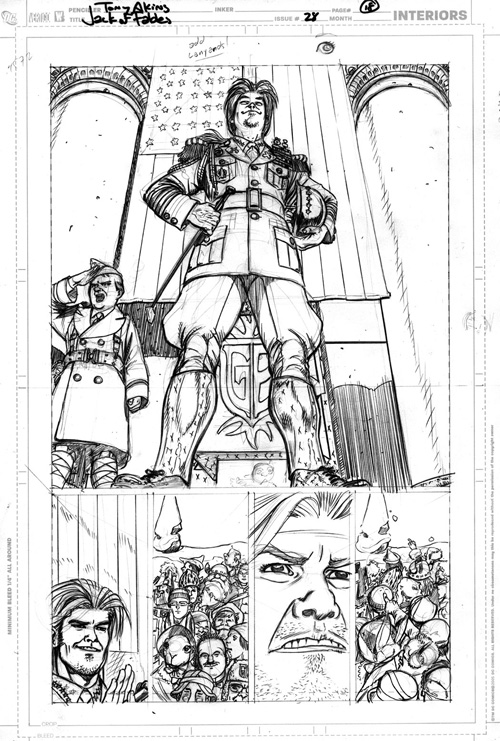
Jack of Fables #28
When he saw me drawing, drawing a lot, I was at De La Salle Institute, a Catholic school on the South Side. I was on the yearbook staff, doing illustrations for yearbook, I think it was my sophomore year. He saw that I was taking to this, and just wanted to give me fatherly, professional advice, which I railed against, because I'm 15, that's what you do. The relationship became very conflicted. I wanted to do things my way, his way was an old-fashioned way. At the time, that's how I looked at it, but of course both ways are terrific. So he really was making sure that I was making it, taking care of my classes, knowing for sure what it was that I wanted to do.
So after high school, I was considering the Air Force Academy in Colorado Springs. But my mom happened to tell me that there was a new school, a new facility downtown, attached to the Art Institute: SAIC. They had just finished, they built the facility in '75 -- the building that's on Columbus Drive. It was a brand-new building, and they were promoting portfolio review, so I gathered up my stack of stuff, which was that... a stack of stuff. Went down and had a portfolio review and got in. I was impressed with the school, with the curriculum, and you know, that turned me away from any ideas about the Air Force academy.
Did you always think comics were in your future?
Comics at the time weren't what I was about. I read some comics as a kid, I was impressed largely as a child in the '60s by television, obviously. But it was television like "The Rat Patrol." Of course, the "Batman" TV show was amusing because it had colors. I wasn't moved by animation that was coming out of, that was on television at the time.
With "Superfriends" and "Scooby Doo" and all of that, they were a little bit after the point of interest that I had.
I think that's important, things hitting you at the right time. If it's even five years too late, it's not the right time.
It really is. And my dad had the opportunity to work for Disney and he didn't, so he was kind of conflicted about that. When we would watch things together, he would point things out. It was a lot of Tex Avery cartoons, a lot of Warner Brothers, a lot of Bugs Bunny, things that I love to this day. Cartoons that influenced me when I was kid were Johnny Quest, and then when animation sort of took that...that dive, where it became limited animation, backgrounds were flatter, animation jumpier. That didn't interest me. But by that time I had started reading my first real comics, which where creepy, eerie, like Vampirella. Horror and warfare were what I gravitated to, which my dad constantly said would warp my mind, and I think he was right. Those were the comics I gravitated to when I was 10 or 11, and then stopped in '75 or so.
I really didn't pick up comics again until '85.
You picked a good time to come back in.
I really did, yeah. '85 was a pretty incredible time. I had actually been to the Art Institute, I had left the Art Institute, I had left the Air Force, I had come back to Chicago. I had my first job as a professional artist, storyboarding for TV commercials at a studio called Storyboard Studio. It was a suite, a condo on Michigan Avenue, and there were eight of us, and then eventually 12 of us crammed in there, working for this guy John Ortman, working in his style.
I met these other young illustrators who all loved comics, pretty much. Lenin Delsol, who's still working as a color artist in Chicago. But it was those guys who brought comics out of my peripheral vision and front and center. That's kind of how I got caught up on what was going on, and it was pretty cool what was going on. Especially Dark Horse and Love and Rockets, Hernandez Brothers, that just blew me away. So I still wasn't so much about the superhero stuff, but was getting to see that there was more of a pluralistic, varietal spectrum going on in the industry at the time.
Do you feel like that early work with Storyboard Studio, drawing for television production, shaped your style later in comics?
It really did, I think adversely in my opinion, because you know, you're working in advertising, you want to get the message across in a very broad style. Things are very generic, very receptive to an audience. It certainly hurt -- well, not hurt -- but retarded any edge I may have tried to achieve for myself at that time. I was working again in a house style, the style of the lead artist.
How do you think you started to develop an edge?
Trying to break out of the storyboard sort of guideline. There were two teams at the studio, I led one and Lenin Delsol led the other. And Lenin was an amazing artist, at the time he was working for a company based in Chicago called First Comics, who had a pretty good stable of property in artists at the time. He was drawing a book called Starslayer and his style was terrific. He's a phenomenal artist, still is. Still look up to him. Looking to his work, I got the sense of likeness and style that I thought I really wanted to lean towards.
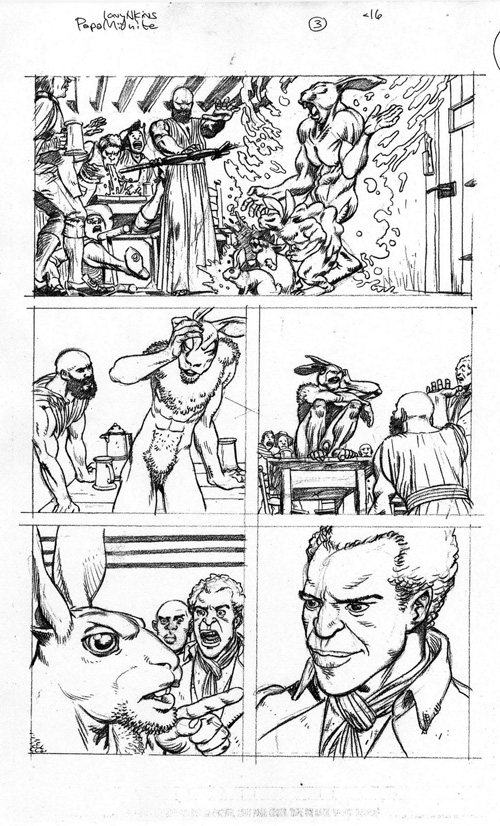
Papa Midnite
What do you feel has influenced your work in the last 10 years?
Anime and manga always played an influencing role on me. My influences as a young artist being impressed by comics, animation, clearly Japanese and European, the first two artists on my list. Hergé, Moebius, and later Satoshi Kon or Katsuhiro Otomo, who did Akira. But again, not so much Akira, but Otomo's work in comics.
And lately, in the last 10 years, certainly drawing Jack, you come into a book, and it's a matter of getting started. Getting the right sense of how things will be drawn. Outside of just the task of telling a story well, laying out the book, making the characters appear the way they need to be...that usually takes the first couple of issues. Once you're done with that seating on a book, then you have the chance to settle in and try to solve the problems of style and from go, as an artist you're a problem-solver -- if you're working with getting a script and synthesizing that idea, breaking it down and making it a two-dimensional representation on paper, then you're problem-solving.
After the real problem-solving has passed, you have to get a sense of what you want the characters to work: how do you discover their gestures, how do you discover the shortcuts of how a character looks when they're facing three-quarters away from you, the shortcut for their manner of standing, of gesture, of cowlick on their hair. That's an ongoing process, and solving those problems, you fall back on tricks that you either learn, or use the way that other artists have solved those problems.
When I'm lost or unsure about how I'm going to approach a story or approach a scene, making that scene easy to draw but still come across to the viewer as something well thought out and well designed, you fall back to people who've preceded you. You stand on the shoulders of giants. My go-to guys on this are Steve Rude, who is a master at the figure. Steve Rude, maybe Art Adams, Kevin Nolan, the guys who are shuffled in my deck as far as guys who know how to get down to the short hairs of a page and make it sing without it looking flat or uninteresting.
It seems like you've come away from comics and come back. What's kept you in Chicago?
That's a good question. In the last couple of years, I have thought about being somewhere else. My girlfriend and I talked about New York, obviously, but she's moved back to Seattle. So, I will probably be moving to Seattle.
This is why I like this job, this is the sort of job that you can do from anywhere, thanks to connectivity. The community here in Chicago, the comic book community, is so robust. I curated a show back in February at a gallery in Andersonville...it was huge. I did it in January because it's mid-winter, let's get out of our studios and do something where we make a showing. The turnout for that was so amazing. I will miss that.
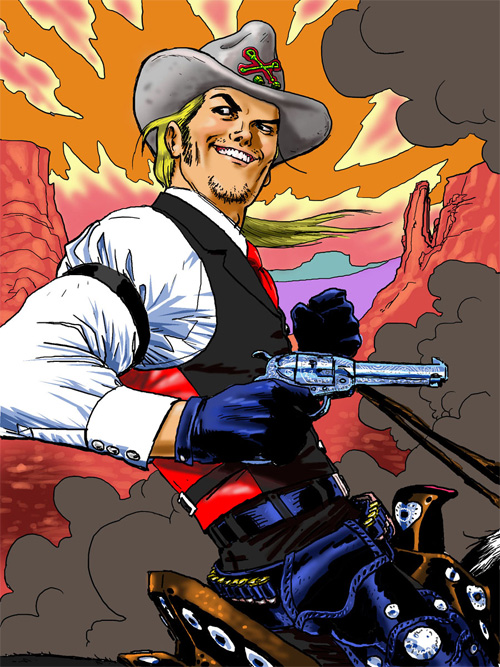
Jack (drawn on a Wacom tablet)







